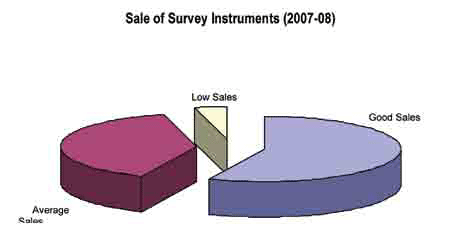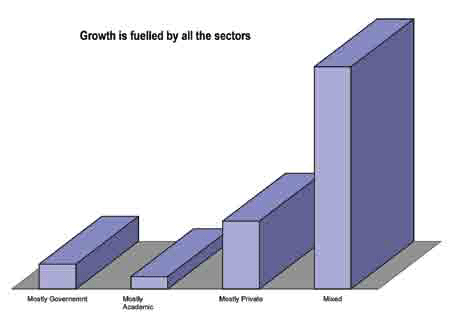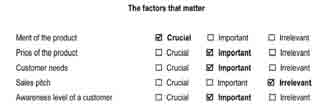| Perspective | |

In the line of sight
|
|||||||||||||||
Contrary to the gloomy economic picture painted by the financial pundits at the end of 2008, the reactions to the global economic slowdown are mixed in the survey equipment industry in India. The growth in the survey industry has been fuelled by the spate of infrastructure projects in the country and may well ride out the economic slowdown wave without feeling the pinch much feel the players in the industry. What will really happen in the coming months remains to be seen, but we do have a picture of the current scenario of the digital survey equipment industry in India. One could have as many views as the number of people one speaks to and we did indeed speak to a wide section of players in the industry to get the entire spectrum of views. The discussions and interactions with the dealers and users focussed on getting a deeper perspective about mindsets rather than just gather data. The growing industryAcross the board everybody agreed that the digital equipment business has been growing, especially in the last few years. Dealers said they have been selling more instruments, and business has been good. Many have moved completely from dealing in conventional instruments to now dealing only in digital equipments. Several new players have entered the market and competition is also growing. Users said they have been buying more instruments to meet the demand of increased projects. Most projects now are time bound and have delay clauses, and with the use of these equipments users have been able to adequately address the survey needs of their projects. Also, acceptance and use of this technology is seen not only in large projects but also small ones. The government and private sector both seem to be contributing to this growth. Dealers said they sell equally to both sectors and users said they undertake projects for both. But, considering that a large number of government projects are further sub-contracted to private organisations, it could just be that the government sector is ultimately driving the growth in the industry. When users were asked about the application areas where they work, ‘infrastructure’ was the most ubiquitous area including projects related to road construction and railway alignments. Another offshoot of the infrastructure projects was the heavy machinery alignment using digital survey equipment. Additional application areas included projects in irrigation and command area development; forestry; environment, urban development; land records and cadastral mapping; mining; police; hydrography; various topographic surveys; education and others. Country wide spreadIt thus emerged that there are now a growing number of application areas where digital survey equipments like Total stations, GPS, levels and Distometers are being used. The presence of dealers and users of the equipment even in small obscure towns of the country indicate the percolation to the technology to the ground level so to say. The distributors and big dealers are no doubt based in the metros, but many now have regional offices and or representation in terms of sub-dealers at the regional level. This spreading network speaks volumes for the support structure that is being slowly created and will ultimately benefit the industry as a whole. As of today, the smaller town dealers do face issues about access to service centres, product information flow from distributors, and availability of spare parts; but hopefully as the networks improve these issues will also be addressed. Therefore an interesting factor that emerged during the discussions is that though they are based in a particular city, the region of operation of both dealers and users seems to be spread well beyond that city. Many users also said they have teams who can undertake projects across the country. The growing awarenessAccording to the dealers most of the customers are quality conscious. This point tallies with another dealer observation that most of the customers today have good awareness, since one could infer that an aware customer would care about quality. Though, a distinction was drawn between being ‘aware’ about products, especially because of the internet; and being ‘educated’ about the potential of the products. Since the technology is evolving continuously, it was felt that constant efforts have to be made to educate the customer. This brought into focus the need for capacity building among potential users. Training of people who buy equipment is being addressed by the dealers, but there definitely seems to be a gap in trained manpower being available to the survey industry in general. A focussed government-industryacademia effort seems to be needed to address this lacuna. The industry could initiate steps like introduction of ‘trial versions’ of equipment in academic institutions so that up-to-date equipment is available for training courses. New specialised courses need to be introduced as well. For the industry to truly grow, it will have to be driven by the users, with maybe just the right push from the government and the dealers. The price debateWhen dealers say that the price of a product is important to some of the customers, and the users also say price is an important factor guiding the purchase of a product, then the emphasis on quality seems to take a beating. If we go with the perception that a good quality product will cost more than other inferior quality products – then the assumption that if quality matters then price should not matter and vice versa should hold good. Following this logic both quality and price cannot be important. But if we question this perception itself – that a high price does not necessarily mean good quality and a lower price does not necessarily mean inferior quality then the whole ‘price-quality’ debate falls flat. Another way to look at this debate is from the small and large projects point of view. A view emerged that on smaller projects the funds are limited and therefore the investment made on equipment is limited and ‘price’ automatically becomes a focus. While on larger projects ‘quality and ‘durability’ become the focus and price is not an issue. The user speaksThe users unanimously wanted to be properly informed about a product. Demonstrations and case studies were appreciated, sales pitch was not. So, it seems the industry is evolving with the user becoming more demanding about his needs. The evolving mindset of the user is reflected in the emphasis that was laid by the users on the appropriateness of a product for the application at hand. This is significant also because today there are a variety of brands and products available to choose from. Understanding which product is suitable for his needs is a big step towards the user driving the market. Most users agreed that though digital equipment was highly technical, its ease of use had definitely helped them to improve their work processes. Brand loyalty by itself may not be a concept well embraced by the Indian user, but a very practical aspect of retaining a brand emerged during the discussions. As the users pointed out, when they continue with the same brand, training, software and servicing aspects are streamlined. After sales serviceWhen dealers said that after sales service is important to most customers and therefore they take special care to provide that service, it seemed like shop talk. Users also said after sales support was an important factor for them, but when a majority said they were satisfied with the service they got it shattered a major myth. The myth that the customer is always unhappy with the after sales service. Conventional instruments marketAmong all the positive talk about digital instruments it emerged that the conventional survey instruments manufacturing in the country has been hit hard by the influx of digital instruments. Though conventional instruments are still being used in the country, especially in the academic institutions, there are few takers for these instruments in the industry. The emerging pictureAs the survey technology develops the Indian survey industry is accepting this technology with open arms. This acceptance comes from a growing understanding about the technology and its benefits. As mindsets change, identifying problems and working towards solving them becomes easier. Though the dealers and users seem to be in tandem, the technology seems to be vendor driven as of now. But, once a technology is introduced and takes root eventually it is the users who will have to push it. |
|||||||||||||||
|
|||||||||||||||
|















 (No Ratings Yet)
(No Ratings Yet)





Leave your response!